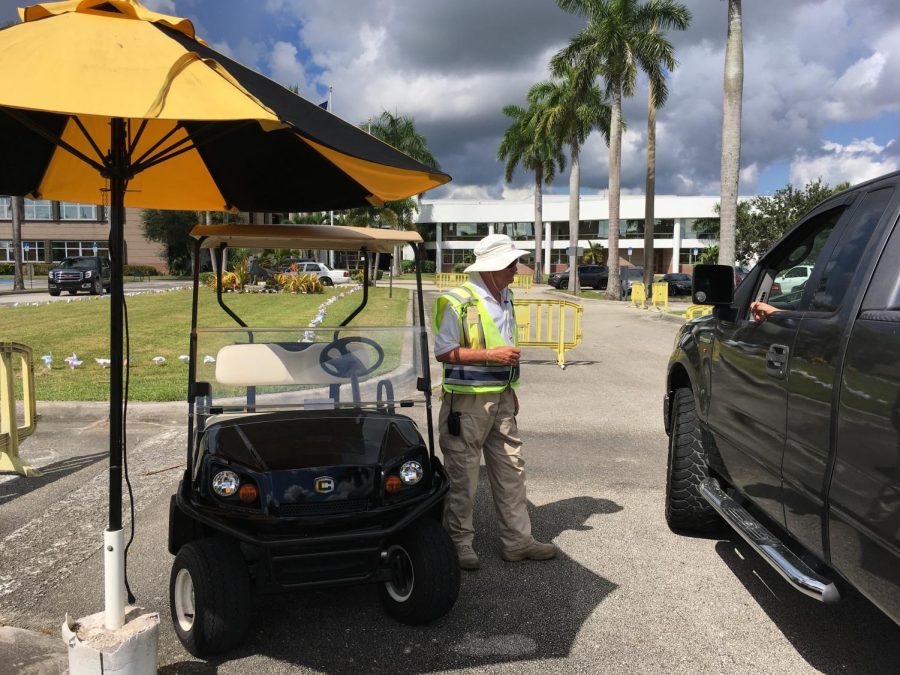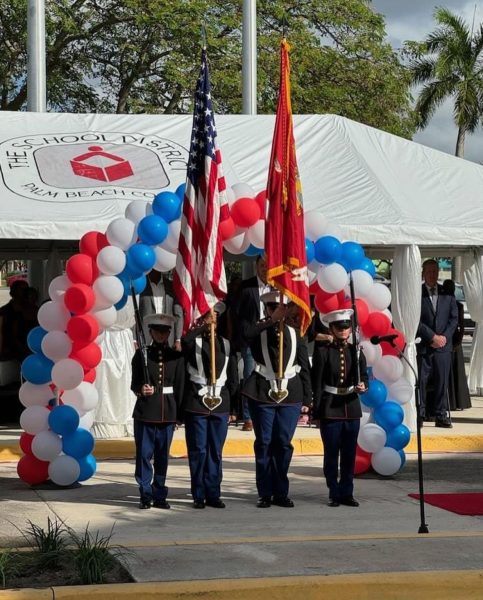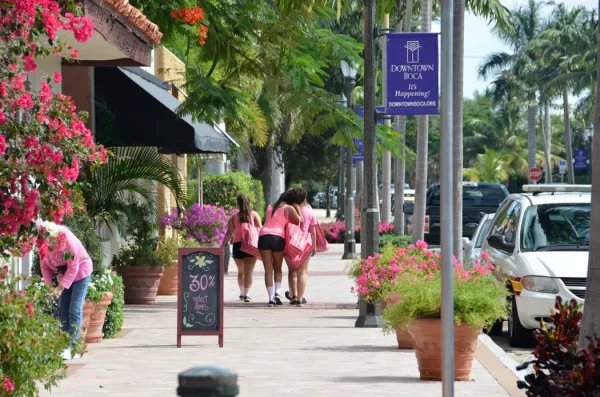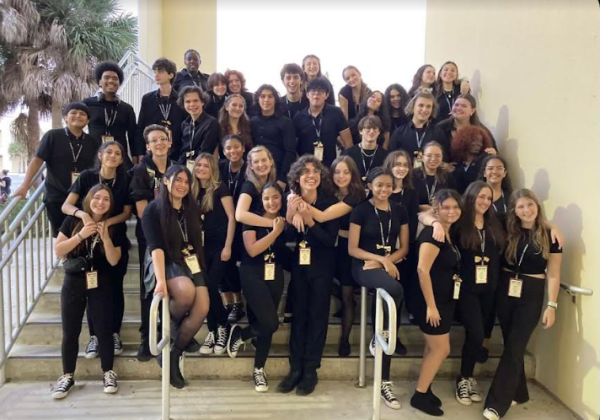School District, Olympic Heights Taking Steps to Make Campus More Secure
Olympic Heights security officer Mike McCutcheon checks the ID of a campus visitor at the school’s main gate.
Ever since the tragic Marjory Stoneman Douglas shooting in Parkland, Florida on Feb. 14, 2018, schools around the country have taken initiatives to increase safety. Palm Beach County schools, including Olympic Heights, are among those schools attempting to provide a more safe environment for their students and staff.
PBC School District Superintendent Dr. Donald E. Fennoy II announced that for the 2018-2019 school year and beyond, there will be a law enforcement officer on every campus. Here at OH students can already feel the heightened security presence as it is difficult not to see OH school resource officer, Officer Brian Khan, patrolling the school throughout the day or to see security guards stationed in the front of the school as students arrive to begin our day.
In order to counteract the ability of individuals to be able to just walk on campus unknowingly, a new safety procedure has been developed and now more recently, enforced. When visitors attempt to enter the OH campus, security personnel check their identification as soon as they come in through the front gate of the parking lot.
“There was always someone out there, but we weren’t making sure licenses were checked,” articulates Khan. In addition, there is now someone stationed at the main entry point at the front of the school who checks ID once more. From there, visitors must head to main office where they are checked a third time before they can receive a visitor’s pass. This was never done before, and it may seem rather tiresome now, but measures are on the way to mend this system.
According to Khan, there are construction improvements that are slated for the school to fix that problem. The area in the front of the school that students walk through at drop-off and dismissal is going to be all closed off. Swinging doors will replace the open entrance, and no one is going to come in that way after school starts. In fact, the district is going to build a new entry, just to the left of it.
Khan elaborates, “Where there’s a classroom now, they’re going to take part of that classroom, build a door, and it’s going to have a buzzer and a camera inside,” he adds, “They’re going to put secretaries in there, and it will soon become the new main office, at least for visitors anyways.”
On a different note, one change that affects students more directly than anything else is the fact that they – and staff – must now wear ID badges. And there are consequences for those that do not. For example, if students do not have their ID badge, they could receive a detention.
Sophomore Maria Kaber agrees that the new measures taken at our school should improve our overall safety. “I feel that it is a good idea for students to wear IDs,” she expresses. “ But we should increase security in certain areas of the school at all times, not just in the morning or afternoon.”
However, there seems to be flaws to the new ID requirement. Junior Meer Shahima Hossain finds that the security staff isn’t very thorough in lanyard checking. “Even though we have [an ID] system, not everyone wears them and is checked for it.” To explain, if a student walks on campus, they should be checked by security personnel for their ID. However, this doesn’t seem to be the case all the time. Hopefully, once things settle down here at OH, security will be more detailed in the ID checking, for everyone’s safety.
Nevertheless, what Kaber and many other students aren’t aware of is that the security force is doing more than they’ve ever done to protect the school. Khan and his band of security guards try to keep all the other entry points locked. After morning arrivals are finished, Khan locks the gates around the school which makes it so that there is only one entry point to the school. Yet, the underlying issue that forms the weakness of the security at the school actually roots in the architecture.
Founded in 1991, OH’s architectural technology and structures that surround it are a bit on the outdated side. For example, there are two door gates on either side of the school (the 2000 and 8000 buildings) that are push-doors which can be opened from the inside. So when students want to leave via these exit points in the middle of the school day, they can open the door gate, and they tend to usually not think about closing the door gate behind them. This leaves a big hole so if someone drives in, they can walk in through there and no one will see them. Khan elaborates,“It kills the whole security plan if the doors are left open,” he adds. “But they’re going to take those doors out and put new doors in that automatically close, so hopefully that’ll eliminate that problem.”
The district is also planning on building a cut-through to the bus loop. The way it is now, the security staff has to constantly go over to the north gate (where the bus loop entry is), to open and then relock it for anyone needing entry or exit via that gate, such as delivery truck drivers and Little Lions Preschool parents. Therefore, there needs to be people at all these different places. Once the cut-through from the main parking lot to the bus-loop entrance is built, the north gate can remain locked without interruption until the end of the school day since those needing to get to that area of the school can access it by entering the main gate and utilizing the cut through.
The cut through is something that former OH principal Dave Clark had been trying the get built for years. Now, with the increased emphasis on a single point of entry during the school day, the district will finally be providing for it.
But with the outdated architecture that OH has now, the question remaining is if students feel safe within their own school. Hossain certainly doesn’t. “With our current school security, I don’t feel completely safe,” she admits.
As for the possibility that schools will eventually have metal detectors to ensure even more protection, Khan doesn’t think it’ll come to that. “They’re not going to do that for every kid every day,” he says. “I don’t know how they could. It would slow things down to a crawl.”
In addition to physical school safety, there are also new measures in place to prevent school threats. If the school receives a threat during the school day, and the student making that threat is on campus, school police are going to get to that student as quickly as possible for questioning and possible arrest.
If it is determined that the student making the threat is off campus, police will go to the student’s home for questioning and a possible arrest. Due to recent legislation, any type of threat to the school or any person at the school is now considered a felony.
In fact, one such arrest was made near the end of last year in relation to a threat made to OH. OH student Jose Calderon made a Snapchat video about strapping bombs on cars in the student parking lot. Calderon was arrested, charged with violation of the Marjory Stoneman Douglas High School Public Safety Act (SB 7026) and held on a $50,000 bond.
Calderon told police the threat was a “funny and a joke.” However, law enforcement and the courts are taking any and all threats to schools seriously regardless of the intent of the threat.
With all this in mind, the goal of school is to provide a safe learning environment for all students. But with recent events, that idea is being challenged. Hopefully, with all these new construction improvements and security measures, students will be at less risk when coming to school.
“I don’t want to make any mistakes like what happened at Stoneman Douglas,” Khan comments.














